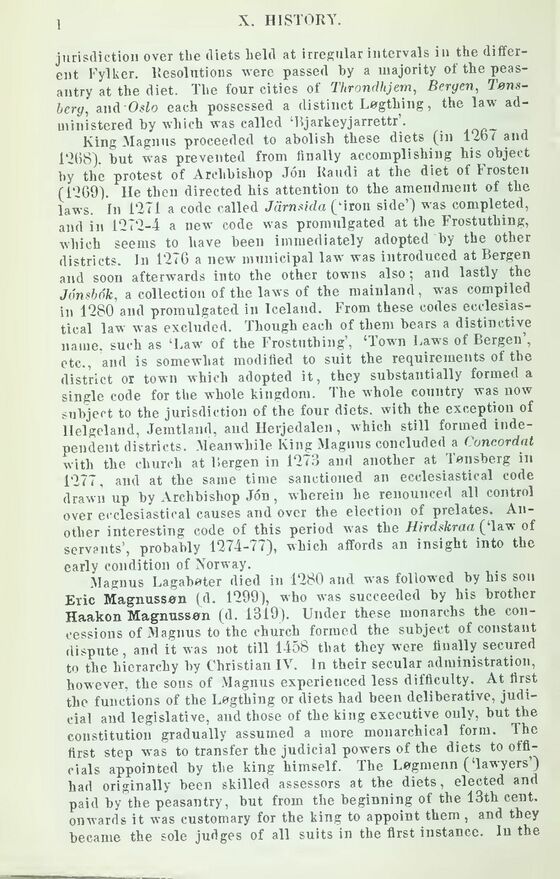
Full resolution (JPEG) - On this page / på denna sida - Introduction - Pages ...

<< prev. page << föreg. sida << >> nästa sida >> next page >>
Below is the raw OCR text
from the above scanned image.
Do you see an error? Proofread the page now!
Här nedan syns maskintolkade texten från faksimilbilden ovan.
Ser du något fel? Korrekturläs sidan nu!
This page has never been proofread. / Denna sida har aldrig korrekturlästs.
jurisdiction over the diets held at irregular intervals in the
different Fylker. Resolutions were passed by a majority of the
peasantry at the diet. The four cities of Throndhjem, Bergen,
Tønsberg, and-Oslo each possessed a distinct Løgthing, the law
administered by which was called ‘Bjarkeyjarrettr’.
King Magnus proceeded to abolish these diets (in and
1*268). but was prevented from Anally accomplishing his object
by the protest of Archbishop Jon Raudi at the diet of Frosten
(i‘269). He then directed his attention to the amendment of the
laws. In i‘271 a code called Järnsida (‘iron side’) was completed,
and in 1272-4 a new code was promulgated at the Frostuthing,
which seems to have been immediately adopted by the other
districts. In 1276 a new municipal law was introduced at Bergen
and soon afterwards into the other towns also; and lastly the
Jönsbök, a collection of the laws of the mainland, was compiled
in 1280 and promulgated in Iceland. From these codes
ecclesiastical law was excluded. Though each of them bears a distinctive
name, such as ‘Law of the Frostuthing’, ‘Town Laws of Bergen’,
etc., and is somewhat modified to suit the requirements of the
district or town which adopted it, they substantially formed a
single code for the whole kingdom. The whole country was now
subject to the jurisdiction of the four diets, with the exception of
Helgeland. Jemtland, aud Herjedalen , which still formed
independent districts. .Meanwhile King Magnus concluded a Concordat
with the church at Bergen in 1276 and another at Tønsberg in
1277, and at the same time sanctioned an ecclesiastical code
drawn up by Archbishop Jon, wherein he renounced all control
over ecclesiastical causes and over the election of prelates.
Another interesting code of this period was the Hirdskraa (Taw of
servants’, probably 1274-77), which affords an insight into the
early condition of Norway.
Magnus Lagabeter died in 1280 and was followed by his son
Eric Magnussøn (d. 1299), who was succeeded by his brother
Haakon Magnussøn (d. 1319). Under these monarchs the
concessions of Magnus to the church formed the subject of constant
dispute, and it was not till 1458 that they were finally secured
to the hierarchy by Christian IV. In their secular administration,
however, the sons of Magnus experienced less difficulty. At first
the functions of the Løgthing or diets had been deliberative,
judicial and legislative, and those of the king executive only, but the
constitution gradually assumed a more monarchical form. The
first step was to transfer the judicial powers of the diets to
officials appointed by the king himself. The Løgmenn (‘lawyers’)
had originally been skilled assessors at the diets, elected and
paid by the peasantry, but from the beginning of the 13th cent,
onwards it was customary for the king to appoint them , and they
became the sole judges of all suits in the first instance. In the
<< prev. page << föreg. sida << >> nästa sida >> next page >>